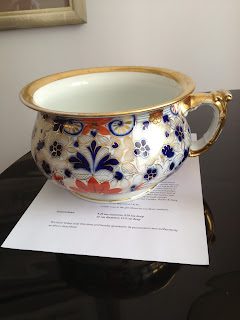A remark by a friend that he was designing a pavilion for himself and now was looking for land in Virginia on which to build, had finally taken root in my brain and sent me to a part of my library – by this I mean not the east wing but a different set of shelves – to look for books about pavilions, follies, gardens and plants. I surprised myself by finding many a book about gardening and gardens (I like one not the other and I'll let you to guess which) and, lurking in "history and biography" a book I hadn't yet read or knew I had. The Architecture of Happiness by Alain de Botton will join the pile of twenty-six yet-to-be-read books on my bedside table – books from friends, my old prof, the Celt and even myself on an occasionally regretted impulse.
I don't know the final design my friend, a lover of orange trees and fragrant blooms, has chosen though I have been privy to a few of his ideas as to style. Neither do I know, but I suspect, what kind of setting he will create, but it will be beautiful – I hasten to add at this point that none of what I write or show here is meant to be either advice or influence. My personal taste whether in decoration or gardening is for strong contrast, for chiaroscuro, the sweet and the sour, the rough with the smooth, for dappled light and, above all, for scent and the patter of rain on leaves.
The photograph above , of a then new garden designed thirty years ago by Arabella Lennox-Boyd for her childhood friend, now the dowager Queen of Belgium, at Le Belvedere, in the grounds of the Palace of Laeken outside Brussels. A beautiful attempt, it seems to me, to humanize the scale of formality and the structural emphasis beloved of André Le Nôtre, set within it Arts and Crafts drift planting, form, texture, scent, light and shade, and moments of repose, and embed it in a lush Capability Brown-style park. I wish it were possible to see it now, nearly thirty years later.
The idea of rooms in gardens, not a new one, persists still – the white garden below, by the late Lady Adeane, epitomizes for me the English garden in all its highly-designed antiquated romantic beauty.
The following gardens are by Pied Oudolf, the garden designer par excellence, plant designer of New York's Highline and in my opinion one of the most exciting garden/landscape designers working today.
Arabella Lennox-Boyd's garden plan and photographs by John Vaughn from The World of Interiors, September 1985.
Photograph of the Philip Johnson Glass House from Architectural Digest.com as is the photograph of the Highline.
Watercolour of a thatched 'hermitage' from Garden Mania: the ardent gardner's compendium of design and decoration.
Photograph of the white garden from David Hicks's My Kind of Garden.
Other photographs of the work of Piet Oudolf from oudolf.com




















%2B-%2BMarie%2BTherese%2BBloneldharau%2Bas%2BFlora.jpg)



















